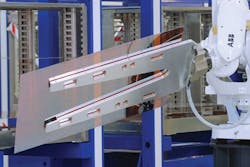In 2011, Aaron Hand was managing editor of Control Design and Industrial Networking. He joined Putman Media after almost 20 years covering high-tech industries, including semiconductor, photovoltaics and related manufacturing technologies.
Looking to get into a market that can bring renewed vigor to a company's bottom line, many machine builders have looked for opportunities over the past few years in the solar game — where the market has seen growth rates of anywhere from 25% to 55% annually (depending on whose numbers you believe). Machine builders from the semiconductor and flat panel display industries, in particular, have brought their automation know-how to the world of solar cell and module manufacturing.
Schiller Automation, headquartered in Sonnenbühl, Germany, is a privately held company that got its start in the automotive business — based in Germany's automotive hub, near Stuttgart — and still makes assembly lines for automotive and power modules. Since the early days, it also has been active in microelectronics production, a heavily automated and detail-oriented process. The company also has been active in the flat panel display market, where it learned to move large substrates; and in bulk chemical dispense.
In short, the company's experience of the past 30+ years gave it the building blocks needed to make a foray into the automation of solar cell production, which it did five or six years ago, according to Mark Willingham, managing director of Schiller LLC in Westborough, Mass. Schiller LLC was formed in 2010 to lead the international expansion of the company's products in the solar equipment market. "Except the solar market is an order of magnitude more than semi," he says. "Instead of having very expensive wafers processed at a couple hundred an hour, solar processes a couple thousand an hour."
Flat panel displays gave Schiller Automation the experience it needed to move very thin and large glass substrates in thin-film photovoltaics production.
Schiller
Schiller's core competency was customized automation—a good fit for thin-film solar cell manufacturing, which relies on its technology differentiation to compete. So Schiller began working with the industry's leading amorphous silicon (a-Si) turnkey manufacturer. This technology grows thin films of silicon on panels of glass measuring typically more than a meter on each side. "Flat panel displays gave us a lot of experience moving very thin and large glass," Willingham says. "And the detail work gave us experience in doing something difficult in one little spot across a large area."
For its first solar customer, Schiller provided all of the internal automation in the front end (cell production), and in each successive solar fab, it played an increasing role. It now has a hand in automating back-end solar processes (module production) as well, and has made an entry into other thin-film technologies like CdTe and CIGS, as well as wafer-based solar, which makes up the lion's share of what is used today.
The equipment builder is behind some of the biggest names in solar, but it's not a well known name itself. "A lot of people aren't that familiar with Schiller," Willingham says, noting that Schiller is probably the most experienced company people haven't heard of in the solar industry. "We have 1.3 GW of thin-film factory fab automation either installed or contracted this year."
For the crystalline (bulk wafer) lines, factory automation is not the given that it is in the front end of thin-film solar processes. "Automation is important as fabs grow in volume, but it's not inherent," Willingham says. "We automate the larger crystalline lines, but we automate all thin-film lines."
After making its name in customized automation, Schiller is moving toward more standardized solutions for the crystalline solar industry. "The difficult thing about thin film is that everybody is different. It's harder to have one scheme translate across multiple customers," Willingham explains. "That's not true in crystalline."
Amorphous silicon is arguably the most difficult of the solar technology from an automation standpoint, Willingham says, because it's less serial and more of a batch process. "That makes other technologies easier," he says. "The more serial it is, the scheme gets a little easier."
For the crystalline process, the key has been improved production efficiency with an improved footprint — three times the throughput in the same amount of space. "Since we've been around for years, and we've helped a dozen different customers, it's given us insight into how to reduce cost over time," Willingham says. "Usually, at the beginning, you want a fair amount of flexibility. You want to make sure your automation scheme can make up for that. But as you get it together, you want a system that can increase speed without increasing cost. We work with companies to build in flexibility from the start."
About the Author
Aaron Hand
Aaron Hand

Leaders relevant to this article:


